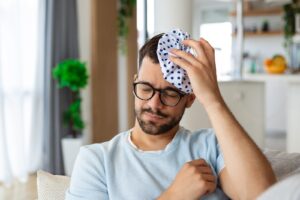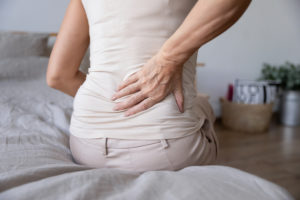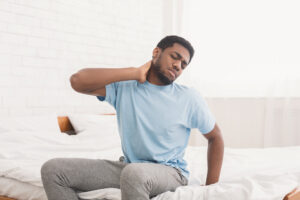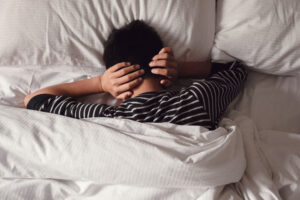Vertigo While Sleeping: Tips and Treatment
Vertigo and dizziness are bothersome symptoms that frequently prompt people to see their doctor. Although vertigo is often harmless, it can disrupt sleep when it occurs at night.
We cover why vertigo can happen when lying down, its potential causes, and how to get good sleep and symptom relief during episodes of vertigo.
Why You Have Dizziness When Lying Down
Vertigo is typically marked by a sensation of spinning that is commonly described as dizziness. Lying down or moving around in bed can involve head movements that may cause or worsen vertigo.
In particular, the most common kind of vertigo, known as benign paroxysmal positional vertigo (BPPV) , can arise when lying in bed, changing your position in bed, or lightly raising your head to look up.
How Is Vertigo Different From Lightheadedness?
Even though people may use the term dizziness to describe both vertigo and lightheadedness, the two issues are different. A sense of spinning makes vertigo distinct from being lightheaded, which involves feeling like you are going to pass out or faint. Lightheadedness is more likely to occur when quickly getting out of bed than when lying down.
Are You Getting Enough Deep Sleep?
A variety of issues can cause degrade your sleep quality. Answer three questions to understand if it’s a concern you should worry about.
What Is the Relationship Between Vertigo and Sleep?
Some research has found that, at least in certain people, vertigo has the potential to disturb sleep . The impact on sleep may be more likely if episodes of vertigo persist over an extended period of time . Similarly, some sleep disorders have been associated with a higher prevalence of BPPV and other forms of vertigo. While more research into vertigo and sleep is necessary, evidence suggests that there may be a bidirectional relationship between them.

How to Sleep With Vertigo
The primary means of reducing vertigo in bed involve avoiding positions and movements that may initiate or exacerbate dizziness.
- Keep movements slow: As much as possible, minimize head acceleration when lying down or getting out of bed. Try to move slowly and deliberately rather than rapidly or suddenly.
- Elevate the head: Sleeping with the head elevated by at least 45 degrees may be effective at reducing benign paroxysmal positional vertigo. Pillows can be used to prop up the upper back, neck, and head to achieve this angle of elevation.
- Sleep with the unaffected ear facing down: Vertigo caused by inner ear conditions such as BPPV may affect only one ear. Episodes of vertigo are more likely when the affected ear is facing down . For that reason, it may be helpful to keep the affected ear out of this position when lying in bed.
- Avoid exacerbating activities: Things like reading and watching TV in bed may worsen vertigo, so it may help to eliminate these from bedtime routines. Exposure to bright lights may also exacerbate dizziness.
Symptoms of Vertigo
Vertigo is a sensation of movement that occurs when a person is not actually moving. People with vertigo may feel like they are spinning, leaning, or swaying. They may also perceive that their surroundings are moving or spinning around them. These sensations can cause a feeling of dizziness and imbalance.
In some cases, vertigo can be accompanied by other symptoms , including:
- Light or sound sensitivity
- Headache
- Nausea and vomiting
- Difficulty swallowing or speaking
- Double vision
- Racing heartbeat
- Sweating
- Shortness of breath
With time, the brain can compensate for vertigo, so symptoms are not constant. Instead, they typically go away or change within days or weeks.
“Vertigo can be a very concerning symptom to the patient, but it often has reversible or self limiting causes. It is best to seek prompt attention – especially if it’s interrupting sleep.”
Dr. Abhinav Singh, Sleep Physician
What Can Cause Vertigo?
Vertigo is a symptom that can be caused by a wide number of issues that affect the vestibular system, which is how the body maintains balance. Vertigo is more common in older adults , who are more likely to have health issues that contribute to dizziness. Other potential risk factors for vertigo include head trauma, a history of migraines, and use of certain medications.
Causes of vertigo are categorized as either peripheral or central disorders. Peripheral disorders involve the inner ear, while central disorders affect the brain.
Peripheral disorders cause vertigo because the inner ear plays a crucial role in maintaining balance. It is estimated that around 80% of cases of vertigo are peripheral. Three specific kinds of peripheral disorders are most likely to cause vertigo.
- Benign paroxysmal positional vertigo (BPPV): This common peripheral disorder happens when loose calcium fragments in the inner ear disrupt the body’s perception of motion. BPPV may result from head injuries or other disorders that affect the inner ear, but in many cases, there is no evident cause . Vertigo from BPPV often occurs when a person changes their head position, such as when they get in or out of bed. Episodes of vertigo from BPPV usually last for less than a minute.
- Vestibular neuritis: This condition is caused by inflammation of a nerve in the ear. People with vestibular neuritis experience intense vertigo that may get worse with head movements . They may also have other symptoms like nausea and vomiting. The worst symptoms of vestibular neuritis usually only last a few days and then resolve gradually, but some dizziness may linger for months.
- Meniere disease: Fluid buildup in the inner ear can lead to Meniere disease . Risk factors for Meniere disease include ear infections, head injuries, allergies, alcohol use, and taking certain medications. The duration of episodes of vertigo from Meniere disease are quite variable, with the potential to last anywhere from 20 minutes to 24 hours. Hearing loss or abnormal sounds and sensations in the ears may occur alongside dizziness. Though it can become chronic, Meniere disease can usually be effectively treated or may even go away naturally.
Vertigo caused by central disorders that affect the brain account for 20% of vertigo cases. Central nervous system disorders that can cause vertigo include certain migraines, stroke, tumors, and multiple sclerosis.
When to Seek Help for Vertigo
Although vertigo can be disorienting and bothersome, some of the most common causes of vertigo are relatively harmless. However, other causes can be serious health issues. You should get prompt medical attention if you experience vertigo with certain additional symptoms, including:
- 100.4ºF or higher fever
- Severe headache
- Difficulty hearing or talking
- Vision problems including double vision
- Tingling sensations
- Difficulty walking without help
- Persistent vomiting
- Fainting
- Chest pain
Additionally, if you have a history of stroke, are at a high risk for stroke, or are 60 years old or older, you should seek immediate medical attention if you have an episode of vertigo that continues for multiple minutes or longer.
If you have occasional episodes of vertigo, you should make an appointment with your doctor who can evaluate your symptoms to determine its most likely cause.
How Doctors Treat Vertigo
In general, medical professionals employ three different strategies to treat vertigo.
- Alleviation of symptoms: Sensations of vertigo can be treated with medication, although this is generally only useful for longer-lasting or frequently recurring episodes. Symptoms may also be alleviated by avoiding rapid head movements, bright lights, and other exacerbating factors.
- Treatment of underlying condition: When vertigo has a clear cause, treating the underlying condition may bring relief. Fortunately, this type of treatment can be beneficial for several of the most common types of vertigo.
- Rehabilitation exercises: Doctors may recommend rehabilitation exercises that help the brain adapt to overcome vertigo. With some types of vertigo, starting these exercises earlier may make them more effective.

Still have questions? Ask our community!
Join our Sleep Care Community — a trusted hub of sleep health professionals, product specialists, and people just like you. Whether you need expert sleep advice for your insomnia or you’re searching for the perfect mattress, we’ve got you covered. Get personalized guidance from the experts who know sleep best.
References
13 Sources
-
Barton, J. (2022, June 23). Benign paroxysmal positional vertigo. In M. Aminoff & D. Deschler (Ed.). UpToDate., Retrieved June 2, 2023, from
https://www.uptodate.com/contents/benign-paroxysmal-positional-vertigo -
Kim, S. K., Kim, J. H., Jeon, S. S., & Hong, S. M. (2018). Relationship between sleep quality and dizziness. PloS one, 13(3).
https://pubmed.ncbi.nlm.nih.gov/29513688/ -
Iranfar, K., & Azad, S. (2022). Relationship between benign paroxysmal positional vertigo (BPPV) and sleep quality. Heliyon, 8(1).
https://pubmed.ncbi.nlm.nih.gov/35059515/ -
Shih, C. P., Wang, C. H., Chung, C. H., Lin, H. C., Chen, H. C., Lee, J. C., & Chien, W. C. (2018). Increased Risk of Benign Paroxysmal Positional Vertigo in Patients With Non-Apnea Sleep Disorders: A Nationwide, Population-Based Cohort Study. Journal of clinical sleep medicine : JCSM : official publication of the American Academy of Sleep Medicine, 14(12), 2021–2029.
https://pubmed.ncbi.nlm.nih.gov/30518450/ -
Horinaka, A., Kitahara, T., Shiozaki, T., Ito, T., Wada, Y., Yamanaka, T., & Nario, K. (2019). Head-Up Sleep May Cure Patients With Intractable Benign Paroxysmal Positional Vertigo: A six-Month Randomized Trial. Laryngoscope investigative otolaryngology, 4(3), 353–358.
https://pubmed.ncbi.nlm.nih.gov/31236471/ -
Shim, D. B., Kim, J. H., Park, K. C., Song, M. H., & Park, H. J. (2012). Correlation between the head-lying side during sleep and the affected side by benign paroxysmal positional vertigo involving the posterior or horizontal semicircular canal. The Laryngoscope, 122(4), 873–876.
https://pubmed.ncbi.nlm.nih.gov/22344794/ -
Furman, J. (2021, September 20). Patient education: vertigo (beyond the basics). In M. Aminoff (Ed.). UpToDate., Retrieved June 2, 2023, from
https://www.uptodate.com/contents/vertigo-beyond-the-basics -
Liu, D. H., Kuo, C. H., Wang, C. T., Chiu, C. C., Chen, T. J., Hwang, D. K., & Kao, C. L. (2017). Age-Related Increases in Benign Paroxysmal Positional Vertigo Are Reversed in Women Taking Estrogen Replacement Therapy: A Population-Based Study in Taiwan. Frontiers in aging neuroscience, 9, 404.
https://pubmed.ncbi.nlm.nih.gov/29311896/ -
Palmeri, R. & Kumar, A. (2022, December 26). Benign paroxysmal positional vertigo. StatPearls., Retrieved June 2, 2023, from
https://www.ncbi.nlm.nih.gov/books/NBK470308/ -
Furman, J. (2022, June 28). Vestibular neuritis and labyrinthitis. In M. Aminoff & D. Deschler (Ed.). UpToDate.
https://www.uptodate.com/contents/vestibular-neuritis-and-labyrinthitis -
Moskowitz, H. & Dinces, E. (2022, November 2). Meniere disease: evaluation, diagnosis, and management. In D. Deschler (Ed.). UpToDate., Retrieved June 2, 2023, from
https://www.uptodate.com/contents/meniere-disease-evaluation-diagnosis-and-management -
A.D.A.M. Medical Encyclopedia. (2021, July 26). Benign positional vertigo. MedlinePlus., Retrieved June 2, 2023, from
https://medlineplus.gov/ency/article/001420.htm -
Furman, J. & Barton, J. (2022, November 17). Treatment of vertigo. In M. Aminoff & D. Deschler (Ed.). UpToDate., Retrieved June 2, 2023, from
https://www.uptodate.com/contents/treatment-of-vertigo

































































